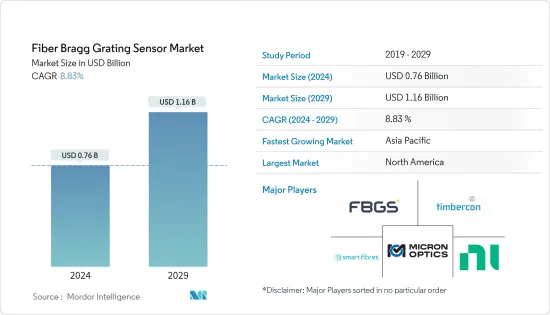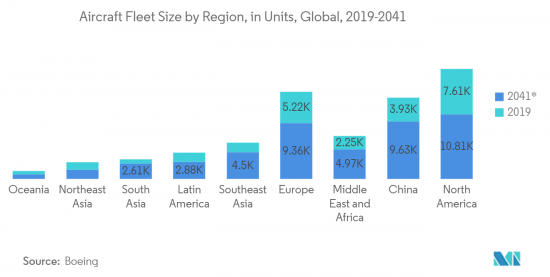 |
市場調査レポート
商品コード
1406269
FBGセンサー:市場シェア分析、産業動向・統計、成長予測、2024年~2029年Fiber Bragg Grating Sensor - Market Share Analysis, Industry Trends & Statistics, Growth Forecasts 2024 - 2029 |
||||||
● お客様のご希望に応じて、既存データの加工や未掲載情報(例:国別セグメント)の追加などの対応が可能です。 詳細はお問い合わせください。
| FBGセンサー:市場シェア分析、産業動向・統計、成長予測、2024年~2029年 |
|
出版日: 2024年01月04日
発行: Mordor Intelligence
ページ情報: 英文 119 Pages
納期: 2~3営業日
|
- 全表示
- 概要
- 目次
FBGセンサー市場規模は、2024年に7億6,000万米ドルと推定され、2029年には11億6,000万米ドルに達すると予測され、予測期間中(2024-2029年)のCAGRで8.83%の成長が予想されます。

主なハイライト
- FBG技術は、製造が簡単で、反射信号強度が比較的強く、動作に柔軟性があるため、温度やひずみ測定用の光ファイバセンサとして普及しています。
- ファイバーコアの屈折率を長手方向に沿って周期的に変調することで、FBGセンサーが形成されます。構造を注意深く決定することにより、光ファイバに様々なセンシング機能を付加することができます。出力の波長エンコード特性により、利用可能な光源スペクトルの異なる波長範囲に各センサを割り当てることで、波長分割多重(WDM)技術の使用が可能になります。校正は物理量と波長の対応関係を決定するために使用され、センサーの性能に影響を与える重要な要因の一つであるため、このような特徴は市場の成長に有利です。
- さらに、他のセンサーよりも寿命が長いことも市場の成長を支える大きな要因です。査読付きオープンアクセス科学雑誌の出版社であるHindawiによると、寿命予測モデルによると、FBGベースのスチールストランドが作業環境で受けるストレスの多い状況下では、ストレスのない状態でのFBGセンサーの基本推定監視寿命は約56年、27年です。
- 1本のファイバーでひずみ、圧力、温度などさまざまなパラメータを測定できるFBGの本質的な能力により、その需要はさまざまなエンドユーザー産業で高まっています。さらに、比較的低コストのFBGを多数配列したマルチポイントセンシングアレイは、設計の柔軟性も高く、さまざまなセンシングアプリケーションに採用される理想的なデバイスとなっています。
- FBGセンサーは、建築物や航空分野における従来の構造監視装置に比べて多くの利点があります。しかし、使用事例によってはコストや技術的な制約があり、普及と成長を阻む大きな課題となっています。
- 調査した市場では、COVID-19パンデミックの影響が顕著に見られました。初期段階では、厳格な封鎖措置のために原材料/部品の供給確保が困難になり、メーカーは世界のサプライチェーンの混乱に直面しました。しかし、状況が正常化し、主要なエンドユーザー産業がさらに事業を拡大するにつれて、これらのセンサーの需要はCOVID後の期間に成長すると予想されます。
FBGセンサー市場動向
航空宇宙はFBGセンサーのエンドユーザーとして急成長
- FBGセンサーは、高精度、リモートセンシング、軽量センサを必要とする航空宇宙工学関連のアプリケーションにおいて理想的なオプションであることが証明されています。この技術は、高圧センシング、地上空力試験設備、衝撃圧センシング、宇宙船モニタリング、航空機複合材の構造健全性モニタリングなど、さまざまな用途で使用されています。
- また、航空宇宙産業においても、主に航空機の翼のモニタリング、機体の疲労など、多くの用途で重要な役割を担っています。また、航空機や宇宙構造物のスマート複合材製造にも利用されています。さらに、過酷で複雑な使用環境が航空宇宙産業を特徴づけており、このような外部環境の極限に耐え、所望の精度、信頼性、精密さ、再現性で機能する適切なセンサーを選択することは、業界のプレーヤーにとって最重要事項です。
- いくつかの航空機メーカーがこの技術の利用に成功しています。例えば、スウェーデンの航空宇宙企業であるSAABは、光ファイバーセンサーシステム過熱検知システム(OHDS)をブリードエア配管のリアルタイム監視に使用し、熱気の漏れを検知しています。同社によると、FBGセンサー技術は、アラームしきい値の設定、動向のトレース、スマートアラーム機能の導入などの機能を備えた実際の温度測定を提供します。
- さらに、航空機製造の増加は、予測期間中の市場の成長を促進すると予想されます。例えば、日本航空機開発株式会社(JADC)によると、エアバスは民間航空機メーカー最大手の一つで、昨年は611機のジェット機を納入しました。予測期間中もその成長軌道を維持すると予想されます。ボーイングの主な競合相手であるボーイングは、昨年340機のジェット機を世界の航空機保有数に追加しました。このような大規模な航空機製造は、FBGセンサー市場の需要を促進します。
- また、様々な地域における航空機保有機数の増加も、航空宇宙産業におけるFBGセンサー市場の需要を促進すると予想されています。例えば、ボーイング社によると、北米地域は2041年までに約10,810機の航空機を保有し、世界最大の航空機フリートのチャートをリードすると予測されています。

アジア太平洋が最速の成長を記録する見込み
- 中国、インド、日本、韓国などの新興国における急速な工業化により、アジアにおけるFBGセンサーの需要は予測期間中に増加します。温度、圧力、ひずみなどのFBGベースのセンサは、水処理・サービス、石油・ガス、鉱業、発電などのプロセス制御産業で広く使用されています。
- 中国、インド、インドネシアなどの各国政府は、製造業の成長を支援するイニシアチブを取っており、市場の成長機会をさらに生み出しています。例えば、中国は2022年10月、製造業への外国投資を可能にするいくつかの措置を発表しました。中国政府は、外資系製造企業の輸出入を促進し、貿易や通関に関する支援を提供すると表明しました。国家統計局によると、2022年9月の中国の工業生産高は前年同月比で6.3%増加しました。
- この地域には、日本、インド、中国といった世界最大級の発電国もあります。例えば、インドは2022年に世界第3位の発電国に浮上しました。(出典:World Population Review)。IBEFによれば、2022会計年度にはインドの発電能力は400ギガワット近くにまで上昇します。
- さらに、FBGセンサーは航空機に広く使用されているため、インドの民間航空産業の成長も市場の成長を促進すると思われます。インド・ブランド・エクイティ財団(IBEF)によると、南アジアにおける航空輸送量の約69%は国内便が占めています。インドの空港容量は、2023年には年間10億回に達すると予想されています。インドは現在、世界第7位の民間航空市場であり、今後10年以内に第3位の民間航空市場になると予想されています。
FBGセンサー産業概要
FBGセンサー市場は、FBGS International NV、Smart Fibres Ltd、Micron Optics(Luna Innovations)、Timbercon Inc.、National Instruments Corporationなどの著名なプレイヤーを中心とした多様な状況によって特徴付けられます。市場参入企業は、製品ポートフォリオを強化し、持続可能な競争力を確立するために、パートナーシップや買収などの戦術を戦略的に採用しています。
その他の特典:
- エクセル形式の市場予測(ME)シート
- 3ヶ月のアナリストサポート
目次
第1章 イントロダクション
- 調査の前提条件と市場定義
- 調査範囲
第2章 調査手法
第3章 エグゼクティブサマリー
第4章 市場洞察
- 市場概要
- 業界の魅力度-ポーターのファイブフォース分析
- 新規参入業者の脅威
- 買い手の交渉力
- 供給企業の交渉力
- 代替品の脅威
- 競争企業間の敵対関係の強さ
- 業界バリューチェーン分析
- COVID-19の業界への影響
第5章 市場力学
- 市場促進要因
- 航空機での使用の増加
- 内蔵キャリブレーションアーティファクトと長寿命化
- 市場抑制要因
- 熱感度と横ひずみ感度
第6章 市場セグメンテーション
- タイプ別
- 温度センサー
- ひずみセンサー
- 圧力センサー
- その他
- エンドユーザー産業別
- 通信
- 航空宇宙
- 建設・インフラ
- エネルギー・電力
- 鉱業
- その他
- 地域別
- 北米
- 欧州
- アジア太平洋
- その他の地域
第7章 競合情勢
- 企業プロファイル
- FBGS International NV
- Smart Fibres Ltd
- Micron Optics(Luna Innovations)
- Timbercon Inc.
- National Instruments Corporation
- HBM Inc.(An HBK Company)
- Broptics Technology Inc.
- ITF Technologies
- Advanced Optics Solutions(AOS)GmbH
- Technica Optical Components LLC
第8章 投資分析
第9章 市場機会と今後の動向

The Fiber Bragg Grating Sensor Market size is estimated at USD 0.76 billion in 2024, and is expected to reach USD 1.16 billion by 2029, growing at a CAGR of 8.83% during the forecast period (2024-2029).
Key Highlights
- Fiber Bragg grating (FBG) technology is becoming a popular choice for optical fiber sensors for temperature or strain measurements because of their simple manufacture, relatively strong reflected signal strength, and operational flexibilities.
- A periodic modulation of the refractive index of the fiber core along the longitudinal direction forms fiber Bragg grating sensors. Various sensing functionalities can be added to the optical fiber by carefully determining the structure. The wavelength-encoded nature of the output allows the use of the wavelength division multiplexing (WDM) technique by assigning each sensor to a different wavelength range of the available light source spectrum. As calibration is used to determine the mapping relationship between the physical quantity and wavelength and is one of the critical factors affecting the sensor's performance, such a feature favors the market's growth.
- Furthermore, a longer lifetime than other sensors is another major factor supporting the market's growth. According to Hindawi, a publisher of peer-reviewed, open-access scientific journals, the life-prediction model indicates that the estimated monitoring life of an FBG sensor in an unstressed condition is about 56 and 27 years under the stressful situations that fiber Bragg grating (FBG)-based steel strands are subjected to in their working environment.
- Owing to their intrinsic capability to measure a variety of parameters, such as strain, pressure, temperature, and many others, along a single fiber, their demand has been increasing across various end-user industries. Additionally, these multi-point sensing arrays of many relatively low-cost FBGs also provide great flexibility of design, making them ideal devices to be adopted for a multitude of different sensing applications.
- Fiber Bragg grating sensors have many advantages over traditional and structural monitoring devices in the building and aviation sectors. However, cost and technological limitations in some use cases are among the significant factors challenging their widespread adoption and growth.
- A notable impact of the COVID-19 pandemic was observed in the market studied. During the initial phase, the manufacturers faced difficulties in securing the supply of raw materials/components due to stringent lockdown measures, which disrupted the supply chain globally. However, with the condition normalizing and major end-user industries expanding their operations further, the demand for these sensors is expected to grow during the post-COVID period.
Fiber Bragg Grating Sensor Market Trends
Aerospace to be Among the Fastest Growing End User for FBG Sensors
- Fiber Bragg grating sensors have proven ideal options in aerospace engineering-related applications requiring high precision, remote sensing, and lightweight sensors. This technology is used in a variety of applications, including high-pressure sensing, ground-based aerodynamic test facilities, shock pressure sensing, spacecraft monitoring, and structural health monitoring of aircraft composites.
- It also has significant uses in the aerospace industry, mainly for airplane wing monitoring, fuselage fatigue, and many others. Also, they have been used in smart composite manufacturing for aircraft and space structures. Furthermore, a harsh and complex operating environment characterizes the aerospace industry, and choosing a suitable sensor to withstand such external environment extremities and perform at the desired accuracy, reliability, precision, and repeatability is of prime importance for the players in the industry.
- Several aircraft-making companies are successfully using this technology. For instance, SAAB, a Swedish aerospace company, uses a Fiber Optic Sensor System Overheat Detection System (OHDS) for real-time monitoring of bleed air piping to detect hot air leakage. According to the company, FBG sensor technology provides actual temperature measurements with the ability to set alarm thresholds, trace trends, and introduce smart alarm functions.
- Furthermore, a rise in aircraft construction is expected to bolster the market's growth during the forecast period. For instance, according to Japan Aircraft Development Corporation (JADC), Airbus is one of the largest commercial aircraft manufacturers, delivering 611 jets last year. It is expected to maintain its growth trajectory during the forecast period. Boeing's main competitor added 340 jets to the global aircraft fleet last year. Such massive aircraft manufacturing will drive the demand for the Fiber Bragg Grating sensor market.
- The growing aircraft fleet size across various regions is also anticipated to drive the demand for the fiber Bragg grating sensors market in the aerospace industry. For instance, according to Boeing, the North American region is anticipated to lead the charts of the largest aircraft fleets in the world, with about 10,810 aircraft in its fleet by 2041.

Asia Pacific is Expected to Register Fastest Growth
- The demand for fiber Bragg grating sensors in Asia will increase over the forecast period due to rapid industrialization in emerging countries, such as China, India, Japan, and South Korea. Fiber Bragg grating-based sensors, such as temperature, pressure, strain, and others, are widely used in process control industries such as water treatment and services, oil and gas, mining, and power generation.
- The governments in countries such as China, India, and Indonesia, among others, are taking the initiative to support the manufacturing industry's growth, further creating growth opportunities for the market. For instance, in October 2022, China announced several measures to enable foreign investment in the manufacturing industry. The Chinese government stated that it would facilitate imports and exports of foreign-invested manufacturing firms and provide assistance regarding trade and customs clearance. According to the National Bureau of Statistics, China's industrial output increased by 6.3% year-on-year in September 2022.
- The region is also home to some of the largest power-generating countries in the world, like Japan, India, and China. For instance, India emerged as the third-largest electricity-generating country in the world in 2022. (Source: World Population Review). As per IBEF, in the financial year 2022, India's power generation capacity rose to nearly 400 gigawatts.
- Furthermore, the growing civil aviation industry in India will also fuel the market growth as fiber Bragg grating sensors are widely used in aircraft. According to the India Brand Equity Foundation (IBEF), domestic traffic contributes around 69% of the total airline traffic in South Asia. India's airport capacity is expected to handle 1 billion trips annually in 2023. India is currently the 7th largest civil aviation market in the world and is expected to become the third-largest civil aviation market within the next 10 years.
Fiber Bragg Grating Sensor Industry Overview
The Fiber Bragg grating sensor market is characterized by a diverse landscape, featuring prominent players such as FBGS International NV, Smart Fibres Ltd, Micron Optics (Luna Innovations), Timbercon Inc., and National Instruments Corporation. Market participants are strategically employing tactics like partnerships and acquisitions to bolster their product portfolios and establish a sustainable competitive edge.
In January 2023, Technica Optical Components marked a significant achievement by successfully manufacturing their one millionth FBG sensor. The company offers an extensive range of FBG products, encompassing FBG sensors, FBG arrays and cables, as well as FBG packaged sensors, positioning the company as a leading provider of fiber Bragg grating sensors.
In December 2022, Technica Optical Components introduced a new line of Fiber Bragg Grating-based Temperature Sensors engineered for operation in cryogenic environments. These sensors feature an advanced unibody micro-structured design, specifically optimized for precise temperature measurements in ultra-low temperature settings. The technology leverages high-precision, advanced cryogenic-rated materials and incorporates Technica-manufactured FBGs within the fiber cores to deliver a transducer configuration characterized by exceptional precision, resolution, and repeatability.
Additional Benefits:
- The market estimate (ME) sheet in Excel format
- 3 months of analyst support
TABLE OF CONTENTS
1 INTRODUCTION
- 1.1 Study Assumptions and Market Definition
- 1.2 Scope of the Study
2 RESEARCH METHODOLOGY
3 EXECUTIVE SUMMARY
4 MARKET INSIGHTS
- 4.1 Market Overview
- 4.2 Industry Attractiveness - Porter's Five Forces Analysis
- 4.2.1 Threat of New Entrants
- 4.2.2 Bargaining Power of Buyers
- 4.2.3 Bargaining Power of Suppliers
- 4.2.4 Threat of Substitute Products
- 4.2.5 Intensity of Competitive Rivalry
- 4.3 Industry Value Chain Analysis
- 4.4 Impact of COVID-19 on the Industry
5 MARKET DYNAMICS
- 5.1 Market Drivers
- 5.1.1 Increasing Usage in the Aircraft
- 5.1.2 Built-in Calibration Artifacts and Longer Lifetime
- 5.2 Market Restraints
- 5.2.1 Thermal and Transverse Strain Sensitivity
6 MARKET SEGMENTATION
- 6.1 By Type
- 6.1.1 Temperature Sensor
- 6.1.2 Strain Sensor
- 6.1.3 Pressure Sensor
- 6.1.4 Other Types
- 6.2 By End-user Industry
- 6.2.1 Telecommunication
- 6.2.2 Aerospace
- 6.2.3 Construction and Infrastructure
- 6.2.4 Energy and Power
- 6.2.5 Mining
- 6.2.6 Other End-user Industries
- 6.3 By Geography
- 6.3.1 North America
- 6.3.2 Europe
- 6.3.3 Asia-Pacific
- 6.3.4 Rest of the World
7 COMPETITIVE LANDSCAPE
- 7.1 Company Profiles
- 7.1.1 FBGS International NV
- 7.1.2 Smart Fibres Ltd
- 7.1.3 Micron Optics (Luna Innovations)
- 7.1.4 Timbercon Inc.
- 7.1.5 National Instruments Corporation
- 7.1.6 HBM Inc. (An HBK Company)
- 7.1.7 Broptics Technology Inc.
- 7.1.8 ITF Technologies
- 7.1.9 Advanced Optics Solutions (AOS) GmbH
- 7.1.10 Technica Optical Components LLC
